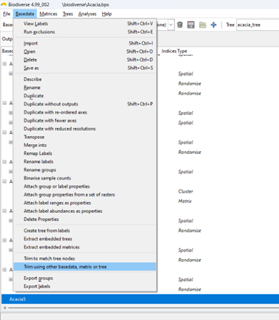2024 is moving quickly, so here is a list of publications from 2023 that used Biodiverse.
If you want to see the full list (211 at the time of writing), then go to https://github.com/shawnlaffan/biodiverse/wiki/PublicationsList
For more details about Biodiverse, see http://shawnlaffan.github.io/biodiverse/
-
Aragón-Parada, J., Carrillo-Reyes, P., Rodríguez, A., Munguía-Lino, G., Salinas-Rodríguez, M. M. and De-Nova, J. A. (2023) Spatial phylogenetics of the flora in the Sierra Madre del Sur, Mexico: Evolutionary puzzles in tropical mountains. Journal of Biogeography, 50, 1679-1691.
-
Copilaș-Ciocianu, D., Sidorov, D., & Šidagytė-Copilas, E. (2023). Global distribution and diversity of alien Ponto-Caspian amphipods. Biological Invasions, 25, 179-195.
-
de Pedro, D., Ceccarelli, F.S., Vandame, R. et al. (2023) Congruence between species richness and phylogenetic diversity in North America for the bee genus Diadasia (Hymenoptera: Apidae). Biodiversity and Conservation, 32, 4445–4459.
-
Dlamini, W.M.D. and Loffler, L. (2023). Tree Species Diversity and Richness Patterns Reveal High Priority Areas for Conservation in Eswatini. In: Dhyani, S., Adhikari, D., Dasgupta, R., Kadaverugu, R. (eds) Ecosystem and Species Habitat Modeling for Conservation and Restoration. Springer, Singapore.
-
Erst, A.S., Baasanmunkh, S., Tsegmed, Z. et al. (2023) Hotspot and conservation gap analysis of endemic vascular plants in the Altai Mountain Country based on a new global conservation assessment. Global Ecology and Conservation, 47, e02647
-
Fernandes, N.B.G., Moraes, A.M. and Milward-de-Azevedo, M.A. (2023) Diversity of the Passiflora L. in the Serra do Mar ecoregion and the relationships with environmental gradients, South and Southeast, Brazil. Acta Botanica Brasilia, 37, e20220314.
-
Flores-Argüelles, A., López-Ferrari, A.R., & Espejo-Serna, A. (2023). Geographic distribution and endemism of Bromeliaceae from the Western Sierra-Coast region of Jalisco, Mexico. Botanical Sciences, 101, 527-543.
-
Flores-Tolentino, M. et al. (2023). Delimitación geográfica y florística de la provincia fisiográfica de la Depresión del Balsas, México, con énfasis en el bosque tropical estacionalmente seco. Revista mexicana de biodiversidad, 94, e944985.
-
Francisco-Gutiérrez, A., Eduardo Ruiz-Sanchez, E. and Lira-Noriega, A. (2023) Biogeography and conservation assessments of the species of Lamourouxia (Orobanchaceae). Acta Botanica Mexicana 130: e2213.
-
González-Orozco, C.E. (2023) Unveiling evolutionary cradles and museums of flowering plants in a neotropical biodiversity hotspot. Royal Society Open Science, 10230917230917.
-
González-Orozco, C.E., Diaz-Giraldo, R.A. and Rodriguez-Castañeda, C. (2023) An early warning for better planning of agricultural expansion and biodiversity conservation in the Orinoco high plains of Colombia. Frontiers in Sustainable Food Systems, 7.
-
González-Orozco, C., Osorio-Guarín, J., & Yockteng, R. (2023). Phylogenetic diversity of cacao (Theobroma cacao L.) genotypes in Colombia. Plant Genetic Resources, 20, 203-214.
-
González-Orozco, C.E. & Parra-Quijano, M. (2023) Comparing species and evolutionary diversity metrics to inform conservation. Diversity and Distributions, 29, 224-231.
-
González-Orozco, C. E., Reyes-Herrera, P. H., Sosa, C. C., Torres, R. T., Manrique-Carpintero, N. C., Lasso-Paredes, Z., Cerón-Souza, I. and Yockteng, R. (in press). Wild relatives of potato (Solanum L. sec. Petota) poorly sampled and unprotected in Colombia. Crop Science.
-
Guo, WY., Serra-Diaz, J.M., Eiserhardt, W.L. et al. (2023) Climate change and land use threaten global hotspots of phylogenetic endemism for trees. Nature Communications, 14, 6950.
-
Mardones, D. and Scherson, R.A. (2023) Hotspots within a hotspot: evolutionary measures unveil interesting biogeographic patterns in threatened coastal forests in Chile. Botanical Journal of the Linnean Society, 202, 433–448.
-
McCurry, M.R., Park, T., Coombs, E.J. Hart, L.J., Laffan, S. (2023) Latitudinal gradients in the skull shape and assemblage structure of delphinoid cetaceans. Biological Journal of the Linnean Society, 138, 470-480.
-
Miller, J.T., Prentice, E., Bui, E.N., Knerr, N., Mishler, B.D., Schmidt-Lebuhn, A.N., González-Orozco, C.E., Laffan, S. W. (2023). Banksia (Proteaceae) contains less phylogenetic diversity than expected in Southwestern Australia. Journal of Systematics and Evolution, 61, 957-966.
-
Molina-Paniagua, M.E., Alves de Melo, P.H., Ramírez-Barahona, S., Monro, A.K., Burelo-Ramos, C.M., Gómez-Domínguez, H., et al. (2023) How diverse are the mountain karst forests of Mexico? PLoS ONE 18, e0292352.
-
Nicolau, G.K. and Edwards, S. (2023) Diversity and endemism of Southern African Gekkonids linked with the escarpment has implications for conservation priorities. Diversity, 15, 306.
-
Ortiz-Brunel J.P., Ochoterena H., Moore M.J., Aragón-Parada J., Flores J., Munguía-Lino G., Rodríguez A., Salinas-Rodríguez M.M. and Flores-Olvera H. (2023) Patterns of Richness and Endemism in the Gypsicolous Flora of Mexico. Diversity, 15, 522.
-
Ramírez-Verdugo, P., Tapia, A., Forest, F. and Scherson, R.A. (2023) Evolutionary diversity of the endemic genera of the vascular flora of Chile and its implications for conservation. PLoS ONE 18(7): e0287957. https://doi.org/10.1371/journal.pone.0287957
-
Ruiz-Sanchez, E., Munguía-Lino, G., Pianissola, E.M., Ely, F. and Clark, L.G. (2023) Richness and endemism in Chusquea subg. Swallenochloa (Poaceae), a Neotropical subgenus adapted to temperate conditions. Phytotaxa, 609, 180-194.
-
Villaseñor, J. L., Ortiz, E., & Hernández-Flores, M. M. (2023). The vascular plant species endemic or nearly endemic to Puebla, Mexico. Botanical Sciences, 101, 1207-1221.
-
Wang, C., Zhu, S., Jiang, X., Chen, S., Xiao, Y., Zhao, Y., Yan, Y. and Wen, Y. (2023) Spatio-temporal variation of species richness and phylogenetic diversity patterns for spring ephemeral plants in northern China. Global Ecology and Conservation, 48, e02752.
-
Ye, C. et al. (2023) Geographical distribution and conservation strategy of national key protected wild plants of China. iScience, 26, 107364.
-
Zhang, H., Chen, S.-C., Bonser, S.P., Hitchcock, T., & Moles, A.T. (2023). Factors that shape large-scale gradients in clonality. Journal of Biogeography, 50, 827-837
-
Zhou, R., Ci, X., Hu, J., Zhang, X., Cao, G., Xiao, J., Liu, Z., Li, L., Thornhill, A.H., Conran, J.G. and Li, J. (2023) Transitional areas of vegetation as biodiversity hotspots evidenced by multifaceted biodiversity analysis of a dominant group in Chinese evergreen broad-leaved forests. Ecological Indicators, 147, 110001
Shawn Laffan
29-Feb-2024










